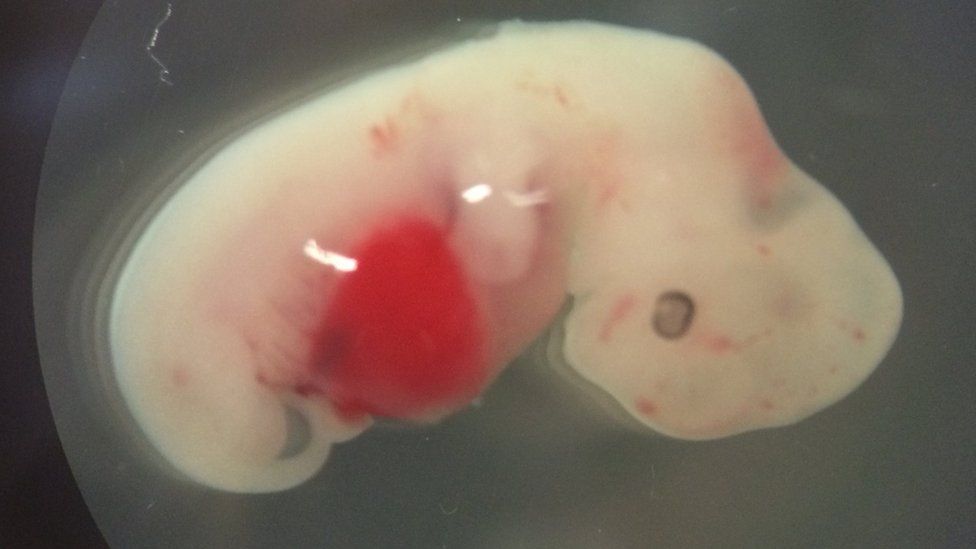Human-pig 'chimera embryos' detailed
- Published

Embryos that are less than 0.001% human - and the rest pig - have been made and analysed by scientists.
It is the first proof chimeras - named after the mythical lion-goat-serpent monster - can be made by combining material from humans and animals.
However, the scientific report in the journal Cell shows the process is challenging and the aim of growing human organs in animals is distant.
It was described as an "exciting publication" by other researchers.
To create a chimera, human stem cells - the type that can develop into any tissue - are injected into a pig embryo.
The embryo - now a mix of human and pig - is then implanted into a sow for up to one month.
The process appears very inefficient - of the 2,075 embryos implanted only 186 continued to develop up to the 28-day stage.
But crucially there were signs that human cells were functioning - albeit as a tiny fraction of the total tissue - as part of a human-pig chimera.
"This is the first time that human cells are seen growing inside a large animal," Prof Juan Carlos Izpisua Belmonte, from the Salk Institute, told the BBC News website.
Commenting on the inefficiency, Prof Belmonte said: "Humans and pigs are separated by a long time in evolution."
Development in the womb is also much faster in pigs - pregnancy lasts less than four months compared with about nine in people.
"It is like a freeway with one car going much faster than another - you're more likely to have an accident," Prof Belmonte said.
He added there was a "long distance" between now and growing animals with human organs - such as a heart, pancreas or liver, that can be transplanted.
However, in the meantime the Salk researchers argue that making chimeras with more human tissue could be useful for:
- screening drugs before human trials
- studying the onset of human diseases
- understanding the earliest stages of human embryo development.
- explaining differences between organs in different species
Dr Jun Wu, part of the research team, told the BBC: "[Getting the efficiency] in the range of 0.1% to 1% human cells should be enough.
"Even at this early stage [28-days], billions of cells in the embryo would have millions of human cells, then testing would be meaningful and practical."
There was no evidence that human cells were integrating into the early form of brain tissue.
Organ breakthrough
On Wednesday, a study in the journal Nature showed how organs could be grown in one species for use in another: by making some room.
Rats were genetically modified so they could not produce a pancreas - the organ crucial for controlling blood sugar levels.
Mouse stem cells were injected in the deficient rat embryos, promptly took advantage of the missing pancreas and grew a mouse one there instead.
This was then transplanted back into mice to treat diabetes.
The work to try this in humans and pigs is already under way.
Although in the long term cows look likely to be a better host for human organs as both cow and human pregnancies last about nine months.
The field is also ethically charged, the US National Institutes of Health at one point imposed a moratorium on funding the experiments.
The researchers have done only research that is legal, but they are aware of the controversy.
Prof Belmonte said: "We are restricting development to one month in the pig, the reason is this is enough for us now to understand how cells mix, differentiate and integrate.
"One possibility is to let these animals be born, but that is not something we should allow to happen at this point.
"Not everything that science can do we should do, we are not living in a niche in lab, we live with other people - and society needs to decide what can be done.
Dr Wu said: "When the public hears the world chimera it is always associated with Greek mythology, there is always this associated fear.
"But angels are chimeras, it can be a positive image and hopefully help with a worldwide shortage of organs, not create a monster."
Prof Bruce Whitelaw, the interim director of the Roslin Institute where Dolly the sheep was cloned, said: "This is an exciting publication.
"It clearly demonstrates that human stem cells introduced into the early pig embryo can form a human-pig chimera.
"This is the first scientific publication to achieve this result.
"This is a first in the development of chimeric animal production and paves the way for significant advances in our understanding of development in the embryo and hints towards future novel biotech applications."
Prof Robin Lovell-Badge, from the Francis Crick Institute, said: "An ability to make interspecies chimeras would be valuable in terms of providing basic understanding of species differences in embryo development and organ function.
"It would also offer the possibility of growing human tissues or organs in animals for transplants - although this is still a long way off.
"The goals of this study are therefore highly laudable."
Follow James on Twitter.
- Published6 June 2016